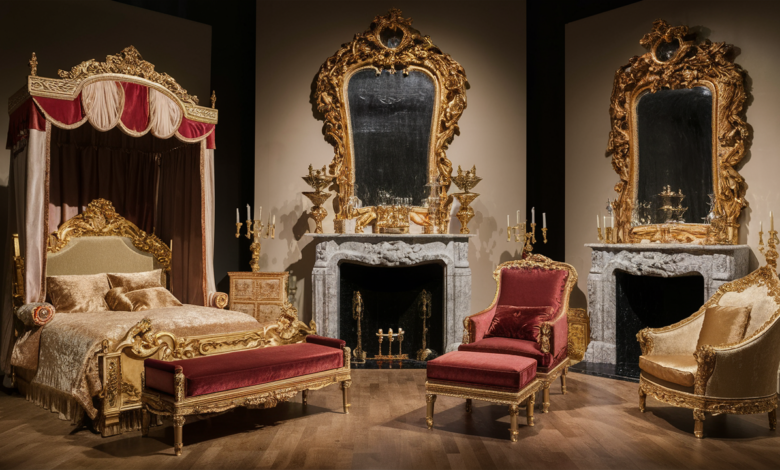Catherine the Great Furniture: A Timeless Legacy of Royal Elegance and Artistic Craftsmanship

When discussing the most influential figures in art and culture, Catherine II of Russia, known as Catherine the Great Furniture, stands among the greatest patrons of creative innovation. Her reign from 1762 to 1796 marked a golden era for Russian architecture, art, and decorative craftsmanship. The furniture commissioned during her time wasn’t simply functional; it was an embodiment of imperial grandeur, reflecting both her European enlightenment ideals and her Russian identity.
Catherine the Great’s furniture became an expression of authority, sophistication, and refined taste. Every piece—from gilded thrones and intricate cabinets to carved chairs and marquetry tables—told a story of power and prestige. The influence of French Rococo and Italian Neoclassicism merged with the distinctive Russian imperial style, creating designs that still captivate furniture enthusiasts and historians today.
The Origins of Catherine the Great’s Furniture
Catherine the Great’s ascent to the throne coincided with a cultural transformation in Russia. She envisioned her empire as the center of European art and intellectualism, which led her to import architects, artisans, and designers from France, Italy, and Germany. Her court soon became a hub of artistic excellence.
Catherine commissioned furniture for her lavish residences—such as the Winter Palace, Catherine Palace in Tsarskoye Selo, and the Hermitage—all of which required the most exquisite furnishings imaginable. The pieces were often created by foreign craftsmen under her direct supervision. Notable artisans included David Roentgen, a German cabinetmaker famed for his secret compartments and intricate inlays, and Charles Cameron, a Scottish architect whose refined Neoclassical taste deeply influenced the Russian court’s aesthetic direction.
The furniture created for these palaces featured innovative mechanisms, exquisite detailing, and rare materials, emphasizing both functionality and artistry—a hallmark of Catherine’s vision for modern Russia.
Design and Artistic Styles in Catherine the Great’s Furniture
1. Rococo Influence
Early in her reign, Catherine was heavily influenced by French Rococo design, known for its ornate curves, floral motifs, and asymmetry. This style represented elegance, femininity, and movement. Many pieces in her private chambers featured pastel tones, delicate carvings, and gold accents, reflecting the Empress’s early taste for opulence and lightness.
2. Transition to Neoclassicism
As Catherine matured as a ruler and intellectual, her aesthetic evolved toward Neoclassicism, which was rooted in the ideals of reason, harmony, and ancient Greco-Roman art. Furniture from this period featured clean lines, symmetry, and motifs such as laurel wreaths, columns, and classical figures. This shift paralleled her political persona—a wise, enlightened monarch leading a modern empire.
3. Symbolism and Personalization
Catherine’s furniture often carried personal symbols—like the imperial eagle, her monogram “E II,” or allegorical depictions of wisdom and justice. These elements weren’t mere decoration; they represented her authority, intellect, and enlightened rule.
4. Use of Luxurious Materials
Her furniture incorporated mahogany, rosewood, ebony, ivory, tortoiseshell, and gilt bronze, often adorned with hand-painted porcelain plaques or gold leaf detailing. Such combinations not only demonstrated wealth but also the sophistication of Russian craftsmanship during her reign.
Notable Examples of Catherine the Great’s Furniture
The Hermitage Cabinets
Inside the State Hermitage Museum, visitors can still admire the original pieces commissioned by Catherine. The “Roentgen Cabinet,” built by David Roentgen, stands as a technological marvel with secret drawers and hidden writing surfaces. Its intricate marquetry of floral designs and mechanical precision represents the perfect harmony of art and engineering.
The Throne Room Chairs
The ceremonial chairs and thrones in the Winter Palace were made to embody imperial majesty. Gilded with gold, upholstered in crimson velvet, and encrusted with gemstones, they signified both political dominance and divine right—the physical manifestation of Catherine’s power.
Catherine Palace Interiors
At Tsarskoye Selo, Catherine’s private apartments contained delicate Rococo and Neoclassical furnishings, with pastel palettes, mirrored walls, and ornate chandeliers. These rooms showcased her personal sensibility—refined yet commanding.
The Cultural and Historical Significance of Catherine the Great’s Furniture
Beyond beauty, Catherine’s furniture represented political propaganda and cultural diplomacy. Each imported artisan and every commissioned masterpiece was a statement: Russia was no longer a provincial power—it was a European cultural leader. Her taste bridged East and West, merging Russian traditions with the intellectual elegance of the European Enlightenment.
Moreover, her collections helped shape the identity of Russian Imperial design, influencing generations of craftsmen who continued the legacy well into the 19th century. Even today, luxury furniture designers worldwide study her collections to draw inspiration for modern neoclassical interiors.
The Influence of Catherine the Great’s Furniture on Modern Design
Modern furniture makers often reference Catherine’s aesthetic principles—balance, craftsmanship, and symbolism. Many contemporary brands replicate her use of ornamental gold trims, carved motifs, and symmetrical geometry, albeit with a minimalist touch suitable for modern homes.
Designers also admire how Catherine blended innovation with tradition. Her collaboration with mechanical furniture makers like Roentgen set a precedent for combining functionality with luxury—a trend that continues in today’s high-end custom furniture markets.
Why Catherine the Great’s Furniture Still Captivates Collectors
Catherine’s furniture pieces are highly sought after in art auctions and museum exhibitions because they embody a fusion of intellect, beauty, and history. Collectors value them not just for craftsmanship but for their connection to one of history’s most powerful female rulers. Authentic pieces attributed to her era can fetch millions of dollars due to their rarity and artistic heritage.
Even reproductions and inspired designs are cherished for their timeless aesthetic, serving as centerpieces in homes, hotels, and institutions seeking to convey prestige and historical depth.
Conclusion
Catherine the Great furniture stands as a testament to the Empress’s extraordinary taste, vision, and leadership. Every piece tells the story of an era when art, politics, and philosophy converged in the creation of beauty. Her furniture not only beautified palaces but also reflected her intellectual strength and imperial power, transforming Russia into a hub of European art and design.
Today, her influence persists in the world of luxury furniture and neoclassical architecture, where artisans continue to reinterpret her timeless vision of elegance and refinement. In essence, Catherine the Great’s furniture remains more than decoration—it is an enduring legacy of royal artistry and human creativity.
Frequently Asked Questions (FAQ)
1. What is Catherine the Great furniture?
Catherine the Great furniture refers to the luxurious, handcrafted pieces commissioned by Empress Catherine II of Russia during the 18th century, reflecting Rococo and Neoclassical styles.
2. What materials were used in Catherine the Great’s furniture?
Her furniture often used high-end materials such as mahogany, gold leaf, marble, porcelain, ivory, and precious metals.
3. Who designed Catherine the Great’s furniture?
Renowned artisans like David Roentgen, Charles Cameron, and various European craftsmen designed and built her pieces under royal patronage.
4. What style best represents Catherine the Great’s furniture?
A blend of French Rococo and Neoclassicism, characterized by ornate carvings, symmetry, and elegant motifs inspired by classical antiquity.
5. Where can I see Catherine the Great’s original furniture today?
You can view authentic pieces in Russia’s State Hermitage Museum, Catherine Palace, and Winter Palace, which house many of her preserved collections.


